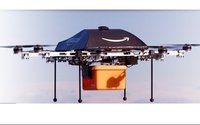Connected In The Air: Drones Take Flight For CNN Video, Amazon Delivery
- by Chase Martin , August 21, 2016
 The
airspace below 400 ft. might see more devices flying soon with initiatives from Amazon, CNN and the White House.
The
airspace below 400 ft. might see more devices flying soon with initiatives from Amazon, CNN and the White House.
CNN recently launched its new CNN AIR division to expand news coverage to aerial perspectives, using Unmanned Aircraft Systems (UAS) like quadcopters with gyro-stabilized cameras on-board.
The AIR unit, which CNN says is shortened from Aerial Imagery and Reporting, will employ two full-time flight operators, who will integrate the new capability into CNN’s entire portfolio of networks and platforms.
Formalizing the AIR unit has been in the works since last year when CNN teamed up with Georgia Tech Research Institute and the FAA to conduct research on best and safest ways to integrate aerial image capturing into CNN’s operations, according to the network.
Along with the FAA, CNN says it has been researching the industry and collecting data to establish a framework for adding these devices safely and legally to the national airspace.
The White House is also heavily investing in and researching the aerial industry.
Earlier this month, the White House allocated $35 million to fund the research of Unmanned Aircraft Systems. Carried out by the National Science Foundation, the research will focus on how to effectively design and control aerial devices, as well as identify the most beneficial applications for the crafts.
In New York, $5 million will be invested to grow the aerial devices industry. The state has also created a business accelerator program called Genius NY, which will award up to $1 million to startups centered around Unmanned Aircraft Systems.
Google’s Project Wing, which aims to bring drone delivery to the masses, is now in operational testing phases at FAA designated test sites in the U.S. The testing is focused on cargo-carrying drone flights and out-of-sight operation, according to the White House.
In addition to flight testing, Project Wing is also working to develop a system to manage the low-altitude airspace in which proposed drone delivery fleets would operate. The airspace management system will be geared toward operating across manufactures and industries to safely integrate all flying devices into the airspace below 400 feet.
The U.S. Patent and Trademark Office recently published a patent application for some of Amazon’s Prime Air drone designs, which GeekWire reports include quadcopter and octocopter configurations with large motors and propellers surrounded by a protective shield to minimize damage in the event the craft hits an obstacle.
Amazon’s drone delivery service, which was also recently cleared for testing in the U.K., is striving to capitalize on the low-altitude airspace, which is currently open for the taking, according to a New York Times report.
“Amazon’s longer-term goal is more fantastical and, if it succeeds, potentially transformative,” the New York Times reports.
“It wants to escape the messy vicissitudes of roads and humans. It wants to go fully autonomous, up in the sky.”
“Drones could be combined with warehouses manned by robots and trucks that drive themselves to unlock a new autonomous future for Amazon.”
Current FAA regulations require that remotely operated aerial vehicles stay below 400 feet.


